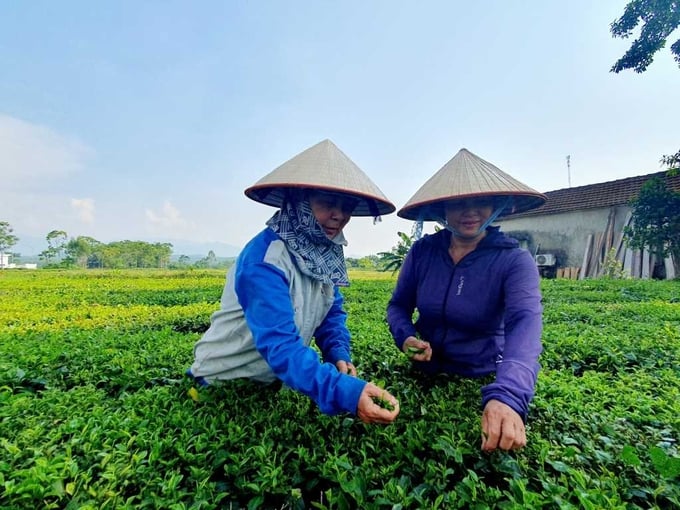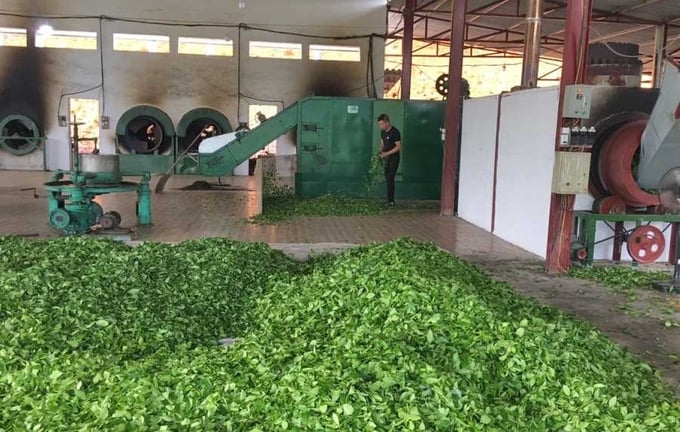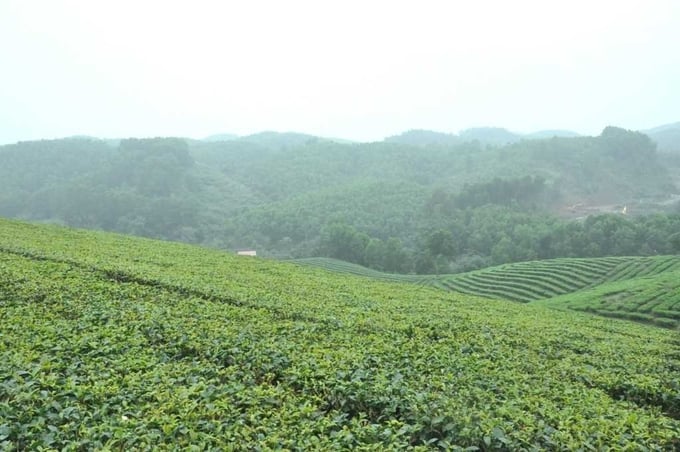May 21, 2025 | 03:43 GMT +7
May 21, 2025 | 03:43 GMT +7
Hotline: 0913.378.918
May 21, 2025 | 03:43 GMT +7
Hotline: 0913.378.918
Those who have the opportunity to pass through the land of Hai Ha (Quang Ninh), will be speechless because right next to National Highway 18A are green tea hills.
From 2013 - 2014, Hai Ha district (Quang Ninh) had up to 980 ha of tea, with a total output of fresh buds reaching over 9,000 tons/year, equivalent to nearly 1,500 tons of dry tea. Taiwan used to be the largest dry tea consumer market of this tea region with over 1,000 dry tons/year (reaching 70% of the total tea output of the entire region). Previously, Taiwan was an easy-going market, accepting raw processed products and especially requiring very low pesticide residue standards compared to other markets.

People in Quang Thinh commune, Hai Ha district take care of tea plants. Photo: Cuong Vu.
By the end of 2015, the Taiwan market tightened regulations on pesticide residues, and the Hai Ha tea area was almost paralyzed. At its peak, in February 2016, Thuan Quynh - Hai Ha's largest tea purchasing unit - had more than 100 tons of dried tea returned by Taiwanese customers due to pesticide residue exceeding the permissible threshold.
From that time on, businesses almost stopped purchasing, people stopped harvesting. The situation of tea production and consumption has stagnated, commercial tea is in full stock, raw tea is aged and slowly becoming wood...
Many tea growers have given up harvesting or switched to other crops, and a large number of young people in the tea area have gone to work as workers in Texhong Industrial Park (Hai Ha district). Hai Ha tea area decreased by nearly 260 ha, down to only 718 ha and is at risk of further decline if it cannot find a consumer market.
As soon as the tea tree was "turned their back on" by the biggest customer, the government, people and businesses of Hai Ha realized the reality. If they want to save the tea region, there is no other way than to change the production thinking, focus on quality, diversify products, diversify markets...
To "save" Hai Ha tea, from 2017 to now, Hai Ha district has focused on improving the value of tea plants by encouraging people to continue to change the structure of tea varieties, including planting new and replacing old, low-yield, low-quality tea varieties with pest-resistant, high-yield, high-quality tea varieties such as Ngoc Thuy, Huong Bac Son, Kim Tuyen...
In addition, the district mobilizes people to invest in intensive farming of commercial tea areas according to good agricultural production processes (VietGAP). Focus on harvesting fresh tea buds; Mobilize businesses and processing facilities to innovate and upgrade technology, especially high-end green tea processing technology, strictly applying the standards of some important stages in processing such as Steaming tea, cruising tea, rolling and classifying before packaging.

Processing tea at the Dung Nga tea production facility (Quang Long commune, Hai Ha district). Photo: Tien Thanh.
"The district has disbursed nearly VND 4.5 billion to mobilize people to improve tea varieties, including converting 35 ha of local tea varieties to Ngoc Thuy varieties. The district sets up a mechanism to encourage businesses to innovate processing technology to create quality tea products. This has supported a model of nearly VND 500 million to improve equipment, while also supporting packaging designs and barcodes for Hai Ha tea products participating in the OCOP program", said Mr. Nguyen Manh Cuong, Chairman of Hai Ha District People's Committee.
Thanks to increased investment, Hai Ha tea has gradually created a certain position in the market inside and outside the province as well as in some countries.
Mr Hoang Van Thuong, a household with a large tea area in Hai Ha district, said: "Thanks to planting new varieties, the quality of tea in the area is more fragrant and delicious; the tea taste is more flavourful; It is also easier for people to consume. Currently, my family's tea yield is 10-12 tons/ha/year".
Each harvest, in addition to the family's labour force, Mr Thuong and many tea-growing households also hire additional workers to harvest and transport tea for consumption, contributing to creating jobs for many workers in the area.
In the first 6 months of 2023, the output of fresh bud tea in Hai Ha district reached 2,880 tons. Upgrading processing facilities and production lines to produce high-quality, high-value tea products has also changed the market structure and purchase price of fresh ingredients in processing facilities. The market for fresh bud tea is stable with an average price of VND 6,000/kg for midland tea, and VND 8,000 - 10,000/kg for Ngoc Thuy tea. As a result, people's living standards in the tea area are increasingly improved.
Although Hai Ha tea has been "revived", the value per ha of tea in Hai Ha is still low, reaching just over VND 33 million/year. Meanwhile, in the Thai Nguyen tea area, the production value of tea trees in many places reaches VND 300 - 500 million/ha/year. The richness of Hai Ha tea is not inferior in comparison with Thai Nguyen tea.

Post-harvest tea hill in Quang Long commune, Hai Ha district. Photo: Cuong Vu.
The reason why the value of Hai Ha tea is low is because there are still many areas of old tea varieties in the area, low productivity, and ineffective investment in intensive farming. Along with that, the previous ease of purchasing by processing facilities has formed the habit of people collecting tea with a lot of long stems, even old leaves, while Thai Nguyen tea is mainly harvested according to the standard "1 young leave every 2 leaves".
In addition, the tea processing technology of many establishments is not high, mainly in raw form, with little emphasis on standard factors for each stage (starching, drying, packaging). Hai Ha tea is mainly exported by businesses as raw materials. The district's dry tea output is about 1,500 tons/year, 700-800 tons are exported to China, the rest is consumed domestically and outside the province.
For many years now, Hai Ha has identified tea as one of the key agricultural products with great potential for development, so the district has set a goal to bring the tea area to 900 ha by 2025, fresh tea bud output reached 8,100 tons, tea production value reached VND 64.8 billion, product value per 1 ha of tea reached VND 72 million...
To achieve the set goal, the district focuses on enhancing the value of tea trees by encouraging people to continue converting the structure of tea varieties, including planting new and replacing old, productive, and low-quality tea varieties with pest-resistant, productive, and high-quality varieties. At the same time, build and promote product images, and expand the consumption market for Hai Ha tea.
Not only promoting structural transformation, the district also actively calls for businesses and individuals to invest in processing, production, and tea consumption in the area and support businesses in the production process; mobilize businesses and processing facilities to renew and upgrade technology, especially high-class green tea processing technology.

The green tea hills in Quang Long commune, Hai Ha district are produced with new tea varieties, giving high yield and quality. Photo: Tien Thanh.
Currently, Hai Ha has 3 tea processing facilities with a capacity of about 15 tons/day/facility and 8 small processing facilities. From 2022 until now, the district has transferred 4 high-quality tea processing technology processes including: Technological process of processing fragrant green tea; technological process of green tea processing; Technological process of processing apricot tea and technological process of processing black tea. Thereby, a number of processing facilities have produced typical products such as: Fragrant green tea, green tea from the Dung Nga tea facility, Thang Hoa facility with ingredients of Trung du tea, Ngoc Thuy, Huong Bac Son; black tea products from Dao Thi Binh facility; Some experimental products of Dung Nga tea facility...
Besides technology transfer, the district also actively supports production facilities to design packaging designs for tea products produced according to new lines and processes; register labels for processing facilities that need them and participate in the OCOP cycle; build a traceability system for products. Currently, the tea products of Dung Nga Tea Processing Facility are 3-star provincial OCOP products. The district also developed 2 new products (soft shrimp tea and black tea) from the Dao Thi Binh tea processing facility to participate in the OCOP cycle and were rated 3 stars.
"Hai Ha district is continuing to synchronously implement solutions on varieties, technical procedures for harvesting and processing care; Strive to have 70% of the tea area in concentrated tea production areas meet VietGAP-oriented safe production to create safe tea products. 100% of tea products from production areas are concentrated for domestic consumption, raw tea for processing and export is certified and declared to be produced according to safe production processes", Mr Pham Van Khoi - Head of the Department of Agriculture and Rural Development of Hai Ha district said.
Translated by Hoang Duy

(VAN) Khanh Hoa is investing over 545 billion VND to develop 240 hectares of high-tech marine aquaculture in order to guarantee a consistent supply of seafood exports and achieve the USD 1 billion target.

(VAN) Minister of Agriculture and Environment Do Duc Duy held a meeting with Soopakij Chearavanont, Chairman of C.P. Group, on May 15.
/2025/05/16/3800-0-nongnghiep-143756.jpg)
(VAN) Suntory PepsiCo Vietnam coordinated with the Ministry of Education and Training to implement an education program on water conservation, reaching nearly 1 million primary school students nationwide.

(VAN) Vietnam’s TH Group officially put its high-tech fresh milk processing plant into operation in the Russian Federation, marking a historic moment as the first TH true MILK cartons were produced in Russia.

(VAN) Use of high-quality broodstock and biotechnology is regarded as the most effective approach to ensuring sustainable and economically viable shrimp aquaculture ahead of climate change and the emergence of increasingly intricate disease patterns.

(VAN) Carbon farming is a form of agricultural practices that helps absorb more greenhouse gases than it emits, through smart management of soil, crops, and livestock.

(VAN) This is a key content of the Memorandum of Understanding recently signed between the Vietnam Fisheries Society and Kunihiro Inc of Japan.